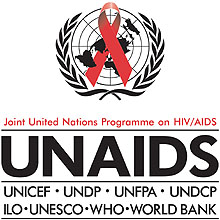World Public Health Threat
According to figures from UNAIDS (July 2002), more than 60 million people have been infected with HIV since the epidemic began two decades ago. In 2001, AIDS had claimed an estimated 3 million lives.
In the 45 most affected countries, it is projected that, between 2000 and 2020, 68 million people will die prematurely as a result of AIDS. The projected toll is greatest in sub-Saharan Africa where 55 million additional deaths can be expected.
In many countries, AIDS is erasing decades of progress in life expectancy. The average life expectancy in sub-Saharan Africa is currently 47 years. Without AIDS, it would have been 62 years. Life expectancy at birth in Botswana (which, at 38.8%, has the highest adult prevalence rate in the world) has dropped below 40 years – a level not seen in that country since before 1950.
 Children and young people are especially hard-hit by the epidemic. The under-five mortality rates of seven countries in sub-Saharan Africa have increased by 20-40%, due to HIV/AIDS. The number of excess AIDS-related deaths among South Africans aged 15-34 is projected to peak in 2010-2015, with an estimated 17 times as many deaths as there would have been in the absence of AIDS.
Children and young people are especially hard-hit by the epidemic. The under-five mortality rates of seven countries in sub-Saharan Africa have increased by 20-40%, due to HIV/AIDS. The number of excess AIDS-related deaths among South Africans aged 15-34 is projected to peak in 2010-2015, with an estimated 17 times as many deaths as there would have been in the absence of AIDS.
Current HIV prevalence levels only hint at the much greater lifetime probability of becoming infected. In Lesotho, for example, it is estimated that a person who turned 15 in 2000 has a 74% chance of becoming infected with HIV by his or her 50th birthday. Even in Guyana, where adult prevalence is a comparatively low 2.7%, the probability of contracting HIV between the ages of 15 and 50 in 2000-2035 is 19%.
The Joint United Nations Programme on HIV/AIDS (UNAIDS) reported in June 2000:
- 19 million HIV/AIDS related deaths have occurred
- 4 million of those deaths were children under 15 years old
- 3 million people died in 1999 alone, nearly 500,000 were children
- in 1999, there was one AIDS related death every 11.2 seconds,
and one new infection every 5.4 seconds - nearly half of the population of sub-saharan teens and twenty-something adults are expected to die before or during their thirties
Your Idle Computer Cycles are Crucial to FightAIDS@Home Project
HIV is a "sloppy copier". In other words, it makes mistakes every time it replicates. In fact, the virus is estimated to produce roughly a billion mutants in a single infected person every day. This is clearly a moving target. Our goal is to find new protease inhibitors faster than HIV can evolve and change to resist them.
By using a version of AutoDock software adapted to work over the Internet, our group can examine millions of candidate drug designs at the same time, and look at how they fare against known drug-resistant mutants of HIV.


